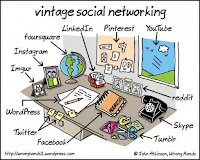Are Today's Youth Really Digital Natives?
What do you make of the (divergent) positions of Boyd and Prensky (per our discussion in class and/or per the article above?) Where do you stand on the “digital native” terminology?
Prensky and Boyd each make valid points in their respective articles regarding the youth and their use of digital media and technology, and I believe that the two complement each other with the notion that, as Boyd said, there needs to be more time invested in developing everyone's media literacy, especially the literacy of the youth. It is not simply the disparity between the "digital immigrants" and the "digital natives" anymore.
During our class discussion about Prensky's argument, we focused mainly on the differences between the "digital immigrant" and the "digital native," and while these differences are important to note, it cannot detract from the Boyd's argument that everybody should be analyzing and verifying the images, texts, and videos coming their way. This digital literacy will only come through explicit teaching; the acquisition and comfort of using technology will come with type and exposure, but exposure is not enough for the deeper, more important factor at stake: literacy.
Individuals are inundated with information daily, and as Boyd attests, Google developers have created the search-bar algorithms to "show results that align with their views" (186) or any other information they may be looking for. Unless individuals are taught how to use and read the text on the screen, what they are learning is a product of the producers' thoughts and beliefs, not the consumer's. Boyd cited Pariser, saying "that personalization algorithms produce social divisions that undermine any ability to create an informed public" (186). Individuals who are connected and linked in are viewing information that reaffirms their beliefs, rather than presenting them with information that prepares them for a world and society comprised of different backgrounds and experiences. We need to have the "critical knowledge to engage productively with networked situations, including the ability to control how personal information flows and how to look for and interpret accessible information" (Boyd 180).
This only forces me to think of the students throughout the country and the world, children who have always grown up in a world with social media and other technologies. What they are familiar with, the ideas and opinions of their families and friends are one of the main sources they have for creating their own opinions. So when they go on to media, they need to be exposed to different opinions and beliefs to support or negate their own, but this is hard when they lack digital media literacy. Since this deeper literacy is not innate (as no real literacy is) and must be taught, all adults need to take responsibility in helping students begin to analyze messages, memes, and videos and look for the greater meaning and truth in them. However, since many adults are not "digital natives," they too must invest the necessary time to understand this new technology as they understand any other given field. Once this work has been done, "parents, educators, and librarians can support [the children] further by helping them turn their experience into knowledge" (180). It is a code of sorts, and once we have cracked this code, a whole new world unravels before us.
Children and all other individuals who can start to master this literacy can then begin to challenge other ideas rampant in society being thrown at them by social media and other forums. We can then begin to pick up on and address the "existing inequalities," hopefully even challenge them. For while technology is readily available in this day and age, Boyd indicates that the quality and quantity of access to technology is tied directly to the socioeconomic status, and herein lies another problem. All individuals need to be taught how to read deeper and develop their digital literacy, but we first must ensure that there is quality access available to all individuals so that not only the "haves" are developing this cognitive function while the "have nots" are relegated to figuring the messages out on their own with the time they have on technology.



As much as I'd like to believe that quality access will be available to all individuals someday, my experience tells me there will remain a "digital divide". I see the difference between technology available in college and community classrooms now with my adult students. While I hope the situation will improve, I'm afraid low income, adult students in continuing education will never, ever be a funding priority.
ReplyDelete